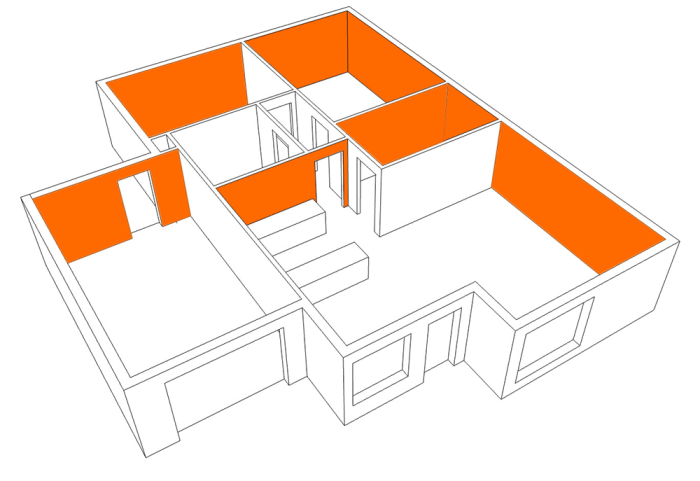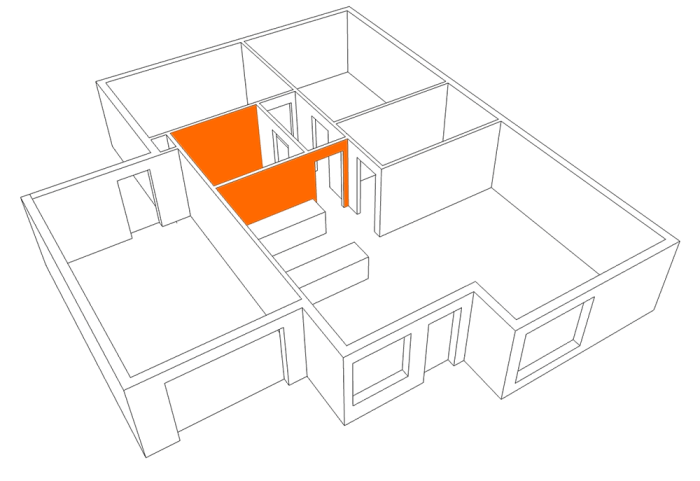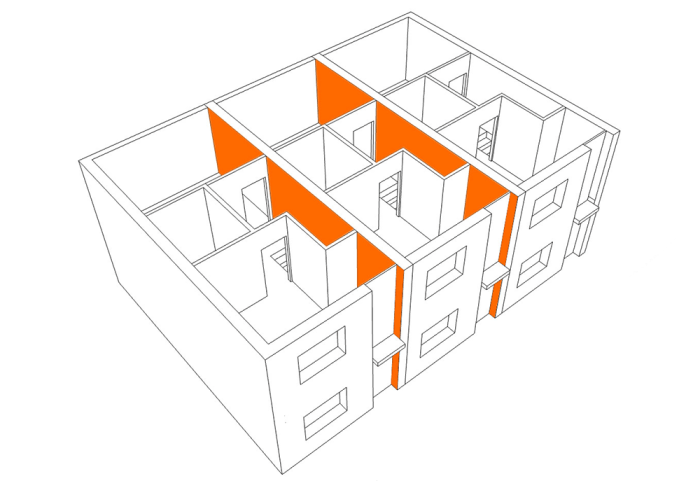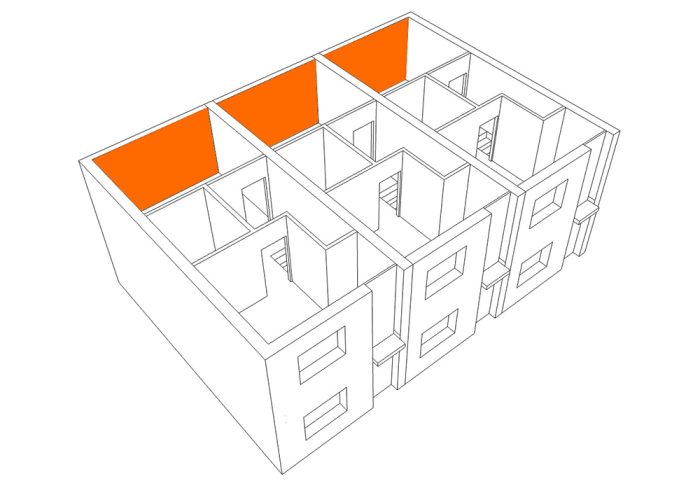Repair and replacement of plasterboard due to flooding
Last updated: 3 November 2025
When a flooding emergency happens and your walls have been damaged, it is likely that the plasterboard will need to be partially, or in some cases, completely replaced.
Information on this page is to assist homeowners, occupiers of buildings, and building practitioners with repairing and replacing damaged plasterboard due to flooding. It will also be useful for other parties involved in this work, such as insurers and councils.
The information applies to newer homes that have been built in accordance with the current Building Code. For older homes with types of construction no longer used, such as lathe and plaster requiring substantial repairs, consider consulting a designer, engineer or a builder who is a Licenced Building Practitioner (LBP) before you remove or replace plasterboard.
Information on removing and replacing plasterboard can also be found in the following guidance documents:
- BRANZ bulletin on restoring a home after flood damage - branz.co.nz
- GIB - Assessment and Remediation of Water Damage - gib.co.nz
Before you start
Before you remove large areas of plasterboard or carry out any repairs or replacement, we recommend you consult an engineer, or a designer or a builder who is a Licenced Building Practitioner (LBP). Also check with your insurer and local council to meet their requirements.
If you are unsure, it is safer to treat all plasterboard as if it is a bracing element and take appropriate safety measures.
Identifying potential damage to plasterboard
Damage to plasterboard may be due to water damage or other flood-borne contaminants, which may cause the plasterboard to become mouldy or discoloured.
It may also occur behind the plasterboard, such as to insulation, wiring, building paper, cavities or connections.
Damage could also occur if there has been movement of the building due to foundation settlement caused by ground movements under or around your house. This could lead to cracking at corners or other junctions.
Repairing damaged plasterboard quickly prevents damage to the strength and safety of buildings.
Why you should repair damaged plasterboard
Plasterboard is one of the most common wall and ceiling linings for houses in Aotearoa New Zealand and often has multiple functions. Water damage or significant movement can affect the safety of the home and the health of its occupants. If flood damaged plasterboard is not replaced it may lead to:
- health issues due to growth of mould - this may not always be visible on the exposed surface of the plasterboard
- reduced stability of the building due to reduced bracing against wind and earthquakes
- reduced support for parts of the building if rot or mould occurs to the structural framing or connections
- reduced protection against the spread of fire to adjacent properties.
Different types and purposes of plasterboard
It can be difficult to identify the type or purpose of plasterboard without expert knowledge or information. The building consent plans will usually show where the different types of plasterboard are located, and these plans, if available, can be obtained from your Council.
To help identify the type of plasterboard, you can take photos of the fixings and any information on the back of the plasterboard if you remove it, or you may be able to find out the use and purpose based on its location in the home. For example:
Plasterboard that contributes to bracing of a building
Timber framed walls are required to be braced to protect the building against wind and earthquakes. In many houses, plasterboard provides bracing for the building and will have specific requirements in the way that it is manufactured, fixed and located. It may not be obvious which walls are providing bracing for the building.
The walls highlighted in this house layout are some walls that could be providing bracing to the building.

Plasterboard in areas splashed by water
Walls that are likely to be splashed by water, such as those in bathrooms or kitchens are likely to have a specific type of plasterboard which is moisture resistant and helps to stop the growth of mould. The moisture resistant plasterboard may be installed on walls and ceilings.
The walls highlighted in the kitchen and bathroom of this house layout could have moisture resistant plasterboard.

Plasterboard on walls separating houses (intertenancy walls)
Townhouses or houses that are joined together with a shared wall (intertenancy wall) may have plasterboard that helps to prevent the spread of fire from one house to another. Plasterboard on intertenancy walls may help prevent noise between the two homes.
The walls highlighted in these townhouses are intertenancy walls which could have plasterboard that is helping to prevent the spread of fire and reduce noise between homes.

Plasterboard on walls close to boundaries
If the building is close to the boundary, the external walls facing that boundary could also have plasterboard that helps to prevent spread of fire. Repair and reinstatement of plasterboard on these walls need to be thought about carefully and will require a building consent.

Removing and replacing plasterboard
If you are unable to identify types or purposes of plasterboard, you should think about how you approach the work before carrying out removal of large sections of plasterboard. If you are unsure, consult an engineer or designer or builder who is an LBP.
Another option is to treat all plasterboard as if it provides bracing to the building and replace it with plasterboard that provides bracing.
Other plasterboard with specific functions (such as fire resistance or soundproofing) will also need to be replaced with products that have the same function and installation details.
If significant sections of plasterboard, i.e. greater than 50 per cent of the individual wall length, need to be (or have already been) removed due to flood damage or to allow framing to dry out, you will likely need some form of temporary bracing to be installed, such as timber cross-braces.
You should check with your local council or a building professional before moving back into a house if large sections of plasterboard will be removed for long periods of time.
Before starting the repairs, it is also important that any cavity spaces, such as between cladding and building wrap where silt and other contaminants may have collected, have been cleared out, and that all timber framing is dry and in good condition.
It is also important that you consider the safety risks to yourself and others. Make sure you and anyone working on your behalf have the correct equipment and resources. Also think about shutting off electricity and gas to the house while the work is being carried out.
Some risks that may be involved in removing plasterboard include:
- dust, mould and debris
- slips trip and falls
- services (e.g. electrical, gas) inside wall or ceiling spaces
- loss of support to part of the building
- exposed services such as exposed wiring and the back of electrical outlets. Measures should be taken to protect access to these if you are reoccupying your home.
The moisture content of timber framing must be below 20 per cent before you replace any plasterboard (some manufactures may recommend 18 per cent or less). Your local council may need to confirm this. This requirement is to reduce future risks of mould growth, timber decay and damage to fasteners and fixings i.e. to ensure the future health and life of the building.
Building work that may not need a building consent
Depending on how much flood damage has occurred to your home, it may be possible that some building work may not need a building consent. This is known as a discretionary exemption, and it allows you to replace or change any or all the plasterboard and finishes of walls, ceilings, or floors of an existing dwelling (whether single or multi-unit). You should first check with a building professional, and there may be other factors to think about such as concealed silt within the exterior cladding cavity.
Your local council will be able to tell you if a building consent is required or if there is the possibility of a discretionary exemption, and what is needed for a discretionary exemption to apply.
Using a different plasterboard brand
You may not be able to find the same brand of plasterboard as the original, so you may need to replace the plasterboard with a different brand.
Find out more about substituting plasterboard [PDF 1MB]
Resources
Quick guide
The quick guide contains the information available on this page, along with some additional information.
Repair and replacement of plasterboard due to flooding quick guide [PDF 1.7MB]